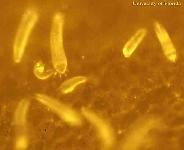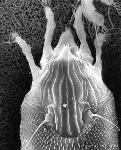Coconut Eriophyid: Aceria guerreronis
Pest population occurs round the year but population maximum during June – Sep coinciding with the onset of monsoon.
Symptoms of Damage:
 |
 |
 |
 |
Yellow patches on leaves
|
Oozing of the gummy exudation |
Brown colour patches on nuts |
V Shaped spindles |
- The earliest symptom on 2-3 month old buttons is pale yellow triangular patches seen below the perianth.
- Later, these patches become brown. Severely affected buttons may fall. As the buttons grow, brown patches lead to black necrotic lesions with longitudinal fissures on the husk.
- Oozing of the gummy exudation from the affected surface of the nuts.
- Uneven growth results in distortion and stunting of nuts leading to reduction in copra yield. In severe cases, the nuts are malformed with cracks and hardened husk.
Identification of the Pest:
 |
 |
| Colony of coconut mite |
Eriophyid mite under microscope |
- Mite are usually found under the bracts of fertilized female flowers and do not infest the unfertilized flowers.
- This mite is very minute in size measuring 200 – 250 micron in length and 36 – 52 micron in width with two pairs of legs.
- Nymph and Adult is pale in colour with elongate body and worm like appearance. The life cycle of this mite, which consists of egg, two larval instars and an adult stage, is completed in 7 -10 days.
Management:
Cultural Method:
- Collect and destroy all the fallen buttons of the affected palm.
- Grow intercrop (sun hemp, four crops/year) and shelter belt with casuarina all round the coconut garden to check further entry.
- Providing adequate irrigation.
- Apply urea 1.3 kg, super phosphate 2.0kg and muriate of potash @ 3.5 kg/palm/year. Increased quantity is recommended to increase the plant resistance to the mite.
- Soil application of micro nutrients like, Borax 50 g + gypsum 1.0kg + Manganese sulphate 0.5 kg/palm/ year TNAU Micronutrient solution 200 ml/tree.
Chemical Method:
Spot application of ecofriendly Botanicals
- Round 1: Azadirachtin 1% (5 ml in one lit. of water)
- Round 2: Neem oil + Teepol (30 ml in one lit. of water)
- Triazophos 40 EC 5 ml/lit or carbosulfan 25 EC 2 ml/ lit in alternation with neem azal 1% 5ml/lit as spot application
- Neem cake application @ 5 kg per palm per year
Preparation of neem oil + garlic emulsion (2%):
- To prepare 10 litres of 2% neem oil + garlic emulsion, 200 ml neem oil, 200 g garlic and 50 g ordinary bar soap are required. Slice the bar soap and dissolve in 500 ml lukewarm water. Grind 200 g of garlic and take the extract in 300 ml of water. Pour the 500 ml soap solution in 200 ml neem oil slowly and stir vigorously to get a good emulsion. Mix the garlic extract in the neem oil + soap emulsion. Dilute this 1 litre stock solution by adding 9 litres of water to get 10 litres of 2 % neem oil + garlic emulsion.
Method of Application
- The botanicals should be applied in the sequence indicated above at 45 days interval using a one litre hand sprayer. Rocker or Pedal sprayer can be used for spraying small trees.
- The spray should be applied at the crown region by a climber covering only the top six bunches during non rainy season.
Precautions and Safety Measures
- Spraying should be avoided during windy season to prevent contamination.
- At the time of spraying, protective mask and clothing should be used.
- Wash face and hands cleanly with soap after spraying.
Biological Method:
- Entomofungal pathogen Hirsutella thompsonii and Verticillium lecanii are reported to be promising in managing the mites.
- Both the pathogens are mass multiplied by a commercial firm and sold in the market.






